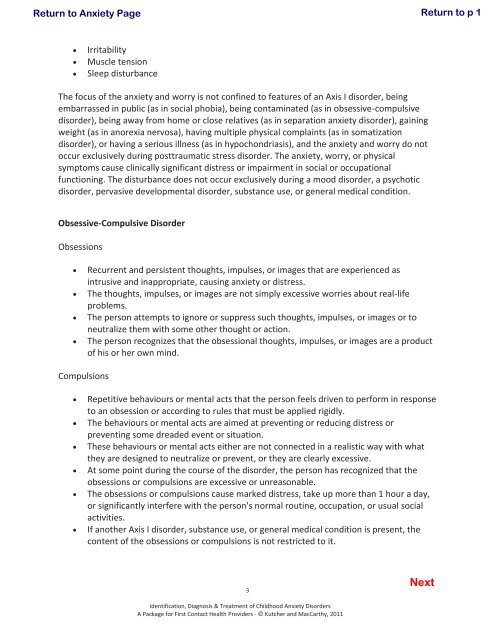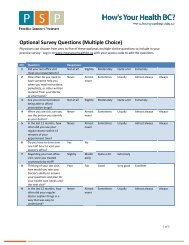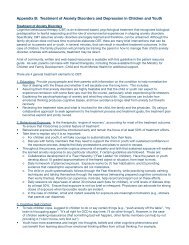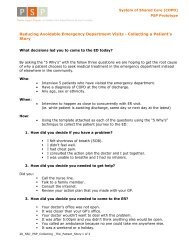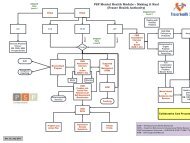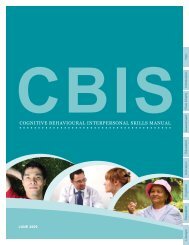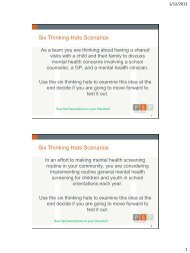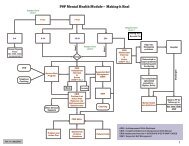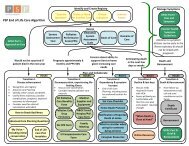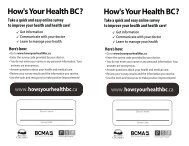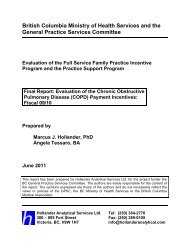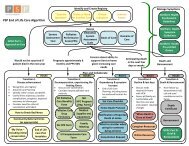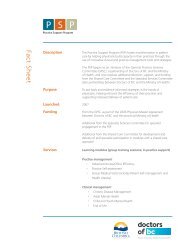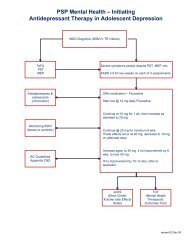- Page 1 and 2:
MOA TasksTools/ResoucesMH Screening
- Page 3 and 4:
Child/Parent or Youth:Child and You
- Page 5 and 6:
PSP Child and Youth Mental Health M
- Page 7 and 8:
Child and Youth Mental HealthPSP Mo
- Page 9 and 10:
Child and Youth Mental HealthPSP Mo
- Page 11 and 12:
Child Functional Assessment (CFA)Th
- Page 13 and 14:
Child and Youth Mental HealthPSP Mo
- Page 15 and 16:
Never or Sometimes Often or Very of
- Page 17 and 18:
Never or Sometimes Often or Very of
- Page 19 and 20:
WEISS FUNCTIONAL IMPAIRMENT RATING
- Page 21 and 22:
Tool for Assessment of Suicide Risk
- Page 23 and 24:
Let’s be clearer with words - Dru
- Page 25 and 26:
Child and Youth Mental HealthPSP Mo
- Page 27 and 28:
Child and Youth Mental HealthPSP Mo
- Page 29 and 30:
Psychotherapeutic Support for Teens
- Page 31 and 32:
Worry Reducing PrescriptionThere ar
- Page 33 and 34:
Safety Card- Emergency Contact Numb
- Page 35 and 36:
DSM-IV Multi-axial SystemPsychiatri
- Page 37 and 38:
CBIS Lifestyle SkillsHealthy Habits
- Page 39 and 40:
Healthy Habits for SleepingDepressi
- Page 41 and 42:
IT’S TRUE: YOU ARE WHAT YOU EAT!
- Page 43 and 44:
CBIS MANUAL | ADOLESCENT VERSION |
- Page 45 and 46:
Tips for Teachers of Anxious Studen
- Page 47 and 48:
LETTER REQUESTING PSYCHOEDUCATIONAL
- Page 49 and 50:
• • • • • • • • •
- Page 51 and 52:
LETTER REGARDING SCHOOL SUPPORTS AN
- Page 53 and 54:
Patient Name:Date of Birth:Physicia
- Page 55 and 56:
Motor Skills (gross/fine): Does thi
- Page 57 and 58:
Child and Youth Mental HealthPSP Mo
- Page 59 and 60:
Have Trouble Getting Up in the Morn
- Page 61 and 62:
2Child: Um. Lots of things I guess.
- Page 63 and 64:
4For children who have worries abou
- Page 65 and 66:
Use with Permission. Guidelines for
- Page 67 and 68:
DSM-IV TR criteriaDSM-IV-TR. Primar
- Page 69 and 70:
DSM-IV-TR. Primary Inattentive type
- Page 71 and 72:
ADHD Assessment ToolsSNAP IV18 Item
- Page 73 and 74:
12 Often runs about or climbs exces
- Page 75 and 76:
SNAP-IV 26 RATING SCALE: SCORING IN
- Page 77 and 78:
Patient Name:Date of Birth:Physicia
- Page 79 and 80: Reason for ReferralReferred by: Pho
- Page 81 and 82: Patient Name:Date of Birth:Physicia
- Page 83 and 84: Functioning and Lifestyle Evaluatio
- Page 85 and 86: Functioning at School (if not at sc
- Page 87 and 88: MENTAL STATUS EXAMINATION (clinical
- Page 89 and 90: Treatment PlanPatient Name: _______
- Page 91 and 92: PSP Child and Youth Mental Health -
- Page 93 and 94: Collaborative Prescribing Agreement
- Page 95 and 96: Referral FlagsReferral of the child
- Page 97 and 98: PSP Child & Youth Mental Health Mod
- Page 99 and 100: 6 - item KADS scoring:In every item
- Page 101 and 102: Permission to use the KADSThe KADS
- Page 103 and 104: Depression in Children and YouthA G
- Page 105 and 106: Use with Permission. Guidelines for
- Page 107 and 108: CHALLENGE NEGATIVE THINKINGQuestion
- Page 109 and 110: 2HOW TO DO IT!Step 1: Teach younger
- Page 111 and 112: It is ver y useful to help a child
- Page 113 and 114: CBIS Cognition SkillsAnti-Depressio
- Page 115 and 116: Small GoalsThe concentration, fatig
- Page 117 and 118: Problem SolvingDepression can make
- Page 119 and 120: Common Thinking ErrorsThe situation
- Page 121 and 122: Thought StoppingDepression often ma
- Page 123 and 124: Use with Permission. Guidelines for
- Page 125 and 126: Referral FlagsReferral of the teen
- Page 127 and 128: DSM-IV TR. Oppositional Defiant Dis
- Page 129: Specific PhobiaA. Marked and persis
- Page 133 and 134: SCARED - Child VersionPg. 1 of 3 (T
- Page 135 and 136: SCARED Scoring - This page is for o
- Page 137 and 138: Screen for Child Anxiety Related Di
- Page 139 and 140: Section B: Fear/Avoidance - Seminal
- Page 141 and 142: Not at all Somewhat Pretty much Ver
- Page 143 and 144: Not at all Somewhat Pretty much Ver
- Page 145 and 146: Weiss Symptom Record (WSR) Instruct
- Page 147 and 148: CY-BOCS Symptom ChecklistChildren
- Page 149: CY-BOCS Symptom ChecklistChildren
- Page 153 and 154: RESOURCES.RESULTS.RELIEF.© Anxiety
- Page 155 and 156: © AnxietyBC3
- Page 157 and 158: CBIS ToolsIntroduction toRelaxation
- Page 159 and 160: Abdominal/Belly BreathingPurpose•
- Page 161 and 162: PurposeGroundingGrounding is a calm
- Page 163 and 164: Passive RelaxationPurpose• Passiv
- Page 165 and 166: CBIS MANUAL | ADOLESCENT VERSION |
- Page 167 and 168: MindfulnessMindfulness originally c
- Page 169 and 170: ThoughtsMindfulness Meditation• A
- Page 171 and 172: For teens: Although you should enco
- Page 173 and 174: This STOP Plan is for:_____________
- Page 175 and 176: FEELING: _____________________FEELI
- Page 177 and 178: THINKING TRAPSThinking TrapsExample
- Page 179 and 180: REALISTIC THINKING FORM (E.g.)Situa
- Page 181 and 182:
REALISTIC THINKINGWe can all be bog
- Page 183 and 184:
Step 3: Challenge your “anxious
- Page 185 and 186:
Tip #3: Alternative balanced statem
- Page 187 and 188:
phobia - when you are afraid of som
- Page 189 and 190:
Chester the Cat feels anxious!How d
- Page 191 and 192:
Panic DiaryDate Trigger Symptoms Se
- Page 193 and 194:
FluoxetinePSP Child and Youth Menta
- Page 195 and 196:
Referral FlagsReferral of the teen
- Page 197 and 198:
ChildandYouthMentalHealthPSPModule
- Page 199 and 200:
ChildandYouthMentalHealthPSPModule
- Page 201 and 202:
ChildandYouthMentalHealthPSPModule
- Page 203 and 204:
ChildandYouthMentalHealthPSPModule
- Page 205 and 206:
ChildandYouthMentalHealthPSPModule
- Page 207 and 208:
ChildandYouthMentalHealthPSPModule
- Page 209 and 210:
ChildandYouthMentalHealthPSPModule
- Page 211 and 212:
ChildandYouthMentalHealthPSPModule
- Page 213 and 214:
ChildandYouthMentalHealthPSPModule
- Page 215 and 216:
ChildandYouthMentalHealthPSPModule
- Page 217 and 218:
AnxietyResources for youth and fami
- Page 219 and 220:
Practice Support ProgramAdditional
- Page 221 and 222:
Practice Support ProgramAdditional
- Page 223 and 224:
FH Referral Flags in the Electronic
- Page 225 and 226:
What doesEPI provide?The EPI Progra
- Page 227 and 228:
Child and Youth Crisis ProgramProgr
- Page 229 and 230:
Fraser Health Child and Youth Neuro
- Page 231 and 232:
Fraser Health Child and Youth Neuro
- Page 233 and 234:
MapContact InformationAddress:Shirl
- Page 235 and 236:
FRASER HEALTH CHILD AND YOUTH PSYCH
- Page 237 and 238:
Fraser Health Infant Psychiatry Cli
- Page 239 and 240:
FRASER HEALTHINFANT PSYCHIATRY CLIN


